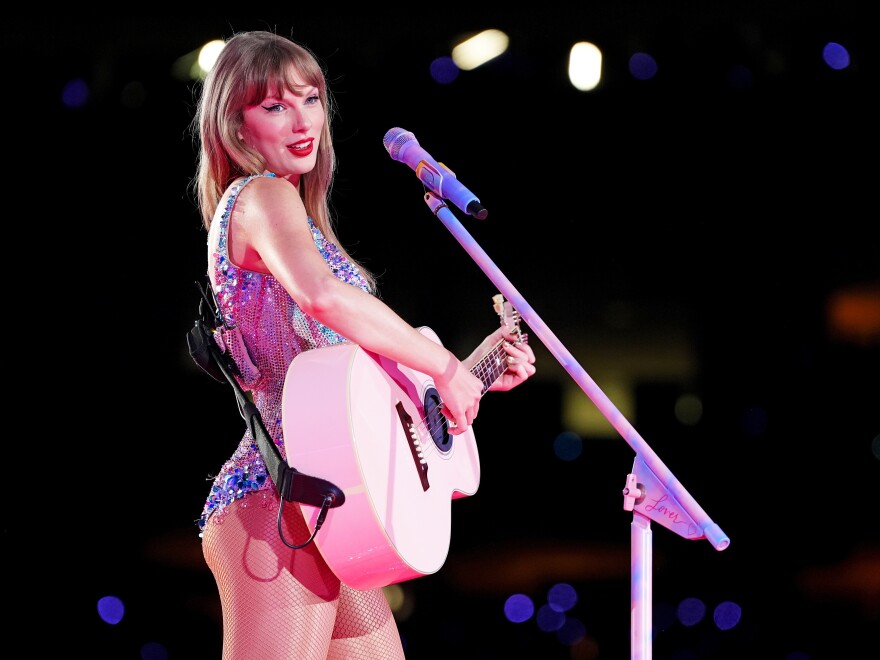The NPR Music email was the first to publish this commentary.Register to receive listening suggestions, early access to articles like this one, and more.
Did you hear the commotion that surrounded the pop music industry last week? Excitement and tiredness colliding could only mean one thing: a squeal followed by a sigh.With a new album cover—which was, of course, hidden in a monogrammed bespoke case—under her arm, Taylor Swift was making her way back to the center of the conversation. The public announcement last Monday that the physical existence of The Life of a Showgirl will be publicly revealed the following day on New Heights, the podcast hosted by Swift’s brother-in-love Jason Kelce and boyfriend Travis, drove critics into an equally impulsive downward spiral and fans into a Pavlovian frenzy. In just a few minutes, Swifties started deciphering hints (also known as “easter eggs”) in the hazy images uploaded to Swift’s website: the glistening orange backdrop fulfilled the promise of the vermillion door leading away from the stage at the conclusion of her Eras tour performances; a TikTok post from last fall that featured Swift in a stadium section designated A12 was now confirmed to be a sign of the day she would make her comeback. The egg hunt was well underway by the time Swift made her podcast appearance, announcing pre-orders on her website and sweetly and solemnly talking about her life with Kelce and her recent victory in the fight for her master recordings.
Non-Swifties, meanwhile, were doing what they always do: complaining about Swift’s failure to take a genuinely rejuvenating vacation from the dominance of the cultural world. We need time to relax and enjoy life with our GQcover man, even though she might not.According to this argument, Showgirl will once more dominate the conversation as click-hungry media outlets scrutinize her every action, mainstream commentators (oh hai) will spout opinions about how her presence has impacted their own self-perception, romantic relationships, and parenting approaches, and all other artists will question where the air in the room has gone. Some negative Nellies loathe Swift because they believe she is overly political or an enemy of the alliances they support, while others grow weary of her the moment they see her because they regard her as a diversion from important political matters. (Swift herself calmly and generously dismisses the critics.) The Kelces, Pedro Pascal, Benson Boone, and Beyonc are likewise a plague on society, keeping us asleep or leading us in the wrong route as the empire falls apart. These criticisms are unrelated to Swift’s music and merely reflect her public presence in the broadest sense.
Others, like myself, would view Swift’s comeback as a labor dispute. Many culture reporters must have experienced the same pressure to come up with the initial hot take in a series that would unavoidably go beyond the album’s October release. Swift’s prodigious output isn’t all that different from that of her colleagues, but it’s greatly boosted by her re-recordings of old songs. For instance, her friend Ed Sheeran has a new core product every two years, supplemented by a variety of extras. She is outpaced by a number of rappers, with Gucci Mane leading the pack with 108 releases, including mixtapes. Swift is also outperformed by rising country music artist Charley Crockett, who has put out 15 new studio albums in half the time the pop diva has had 12 issued. For some, flooding the market is a financial decision, a solution to streaming companies’ flawed monetization strategies; for others, it’s a part of an extraordinarily creative life.
Swift is frequently likened to the Beatles, who within a shorter period of time generated a similar influx of albums, movies, merchandising, and other side endeavors. The Fabs, like Swift, were methodical and disciplined about making music even at their most personally exhausted levels, and the demands that productivity made on a rock press that recognized readers’ insatiable desire to track every move their faves made are what make this comparison true, even though the music industry was very different in the 1960s. After Beatlemania struck in 1964, a New York Times writer remarked optimistically, “Since a craze is a form of inflation, it may precede a crash.” Some culture chroniclers never stopped waiting for that crash to occur. Additionally, he voiced his concern that the group might turn into “the vocal scourge of the whole Western world.”
The Beatles, like Swift, were raised in the spotlight, so with each new album, even the most cynical critics have something to think about. However, it was inevitable that the group’s domination over pop would start to feel burdensome to some. Popularity and cultural significance are equated, not only in the present but also as pop’s canons and legacies are being established. This pattern became increasingly unabated with each decade that went by, even as the members’ extraordinary success as popular artists made wider coverage of adventurous pop music more common. Music journalists and other purported gatekeepers may be weary of Swift today, in part because the technique of judgment that expertise stands for still contains traces of a hierarchy that commercial realities have long overthrown. To be honest, it’s a pointless part of the work—not the discernment itself, which is essential, but the upholding of a dichotomy between what was formerly referred to as “high” and “low” art, which could now be categorized as “mainstream” and “niche” or, if you’re feeling particularly moralistic (which I frequently am), “the 1%” and “the marginalized.” The truth is that every level of popular culture produces exciting, skillfully done art, and judgment should be made at the level of individual pieces while keeping an eye on how the economic structures that help or impede their creators influence those pieces.
The gamification of everything is, in my opinion, the most notable change in music-driven popular culture today, but it is by no means unprecedented. This concept was brought to my attention by my friend, the critic and scholar Eric Harvey, who wrote a scathing Bluesky remark about the declining importance of critics in mainstream magazines the day after Swift’s announcement of Showgirl. “For decades now, people have been conditioned to view popular culture as something to ‘solve’ and the answer keys are on Reddit and YouTube,” stated Harvey. “So why pay critics to essentially give people homework to do?” That reminded me of something. The notion that criticism or “expert” commentary of any kind could detract from fans’ enjoyment of their favorite music instead of shedding light on it got me to thinking about what happens when we make art appreciation into a game with a specific goal, like finding the most easter eggs or, like in museums that give kids placards to guide them through galleries, finding the most preselected details within designated masterpieces. One of the main things that non-Swifties find tiring with her rollouts is the never-ending egg hunt. It occupies a vast amount of space in the minds of people. Additionally, it teaches art lovers to value art in a specific way. For some fans, LovingShowgirl is all about interpreting its cues in predictable ways, with a solution rather than a surprise at the end. Instead of influencing and possibly changing you, art becomes something you master.
Don’t get me wrong: I am aware that Swift’s music has a profoundly positive impact on many Swifties, who use it to get a deeper understanding of their own life. She is one of the most diligent and quietly creative pop performers we have ever had, and some people are even listening with musically sensitive ears, observing her diligence as a songwriter and in the studio. However, the game is the reason behind the noise that is drowning out her signals. Swifties only listen to the music only after the fun has started, and they first interact as numerologists and map readers with each new release. I am not the first to observe that they are acting under the guidance of a master. Swift has the best understanding of how music needs a multi-media frame to keep listeners interested in the attention-deficit century. (She once again enticed fans with a countdown clock on her website on Monday to reveal the new vinyl versions for Showgirl.) Swift has been drawing inspiration from modern phenomena like as Harry Potter and the Marvel Comics Universe to create a virtual world around her music and make that world an eminently solvable mystery since 2012, when she swathed her launch for Red at well-planned fan events.
Swift didn’t really create this strategy; fans did, with some assistance from previous celebrities who both supported and resented their obsessions. It was a form of gamification, the whole “Paul is Dead” story about the bass-playing Beatles. The quest to discover the meaning behind Led Zeppelin’s album title “runes” was no exception. Prince occasionally included subliminal messages in his songs and videos. Scripts were written by Madonna for her personas. Trent Reznor even developed a role-playing game in 2006 to help promote the release of the Nine Inch Nails album Year Zero. K-Pop’s rise came about, in part, because that industry so seamlessly integrated online gaming with music; that’s how we got toK-Pop Demon Hunters. Focusing on the game-like aspect of musical projects, or building them in to define and extend the parameters of those projects, makes fans feel deeply connected to their idols and to each other.
Despite the fact that fans have always made music loving into a game, and that artists have historically engaged with that process in creative ways, the dominance of gamification within music is relatively new. It suits generations who grew up playing video games and learning basic skills like reading and math, in part, from educational adaptations of the same diversions. Anyone Swift’s age or younger could very well comprehend the world primarily in terms of gaming, the way a bookworm learns about it through reading, or an athlete does through the lessons of her body and of team interaction. Given this, making art into a game feels legitimate. But art can also be very different from most games, in that it can be open-ended; it can be something that people abide with, letting its meanings grow and change, rather than “solving” it. I think that’s what Eric Harvey’s comment laments the loss of a sense of art as having meaning that is unfixed, unlimited. As a fan of Swift’s albums, I’ve found many moments that fulfill that definition within her recorded work. But I’m not always sure her presentation of that work encourages such richly personal and varied interpretations.
I could be wrong here. I believe Swift is a true artist, devoted to the process first, whether that’s writing all the time, spending endless hours in the studio, or giving 110% during her performances. Her interest in gamification is an aspect of her total absorption in the creative process. She’s said during herNew Heightsappearance that she will never gamify her personal life; every egg she hides in the grass of the agora leads back to her songs, not the gossip pages. She does want people to think of her as a musician first, not as an avatar. Yet her successful method for continually amplifying her efforts exemplified by that appearance on her partner’s podcast (as he welcomed the ratings boost it would bring) to debut her latest offering illustrates the difficulty this most 24/7 pop star has with separating work and love, work and play. She’s hinted that whileShowgirlwill be a happy album that makes people want to dance, it will also explore the experience of being Taylor Swift across the whole game board of her life. I’m looking forward to hearing how her new music connects the pieces.
Copyright 2025 NPR






